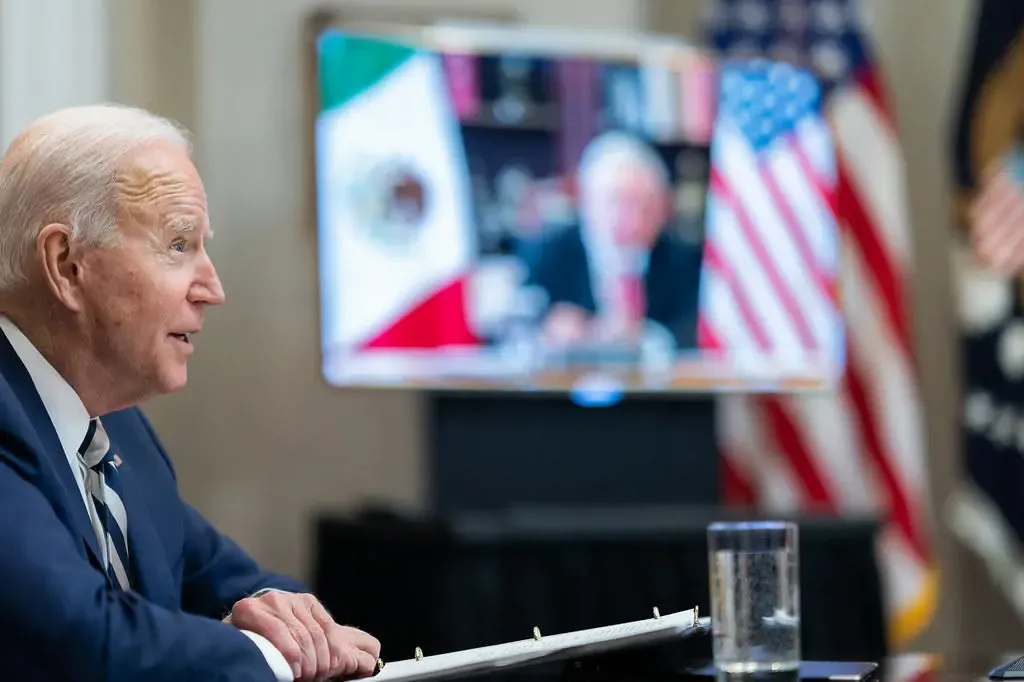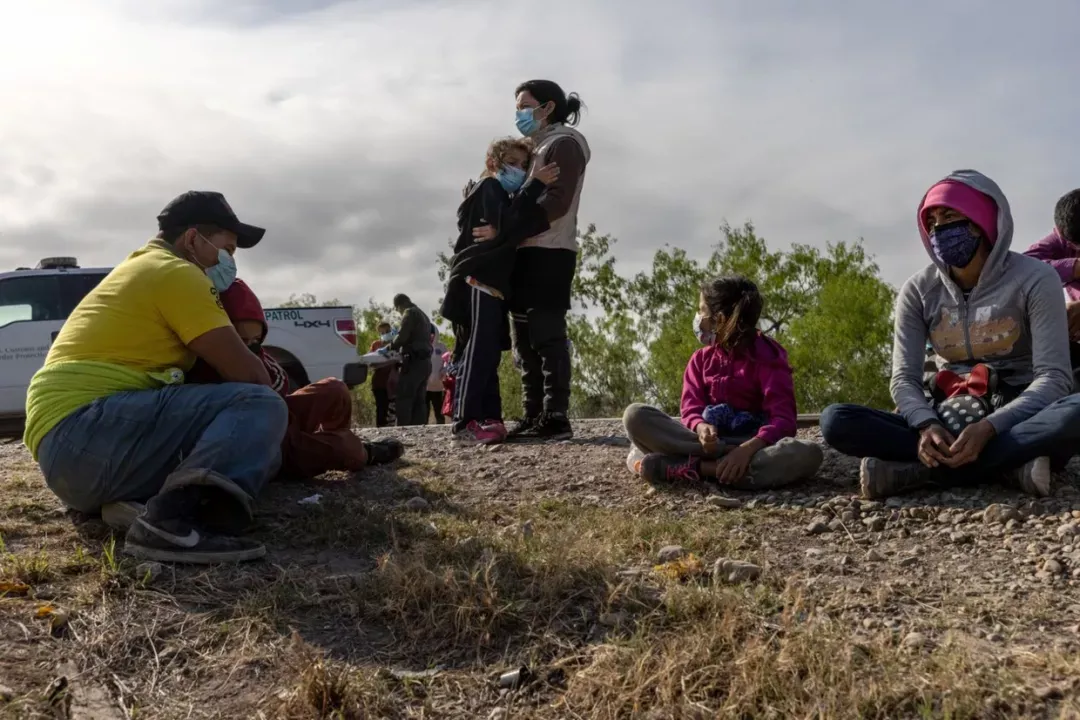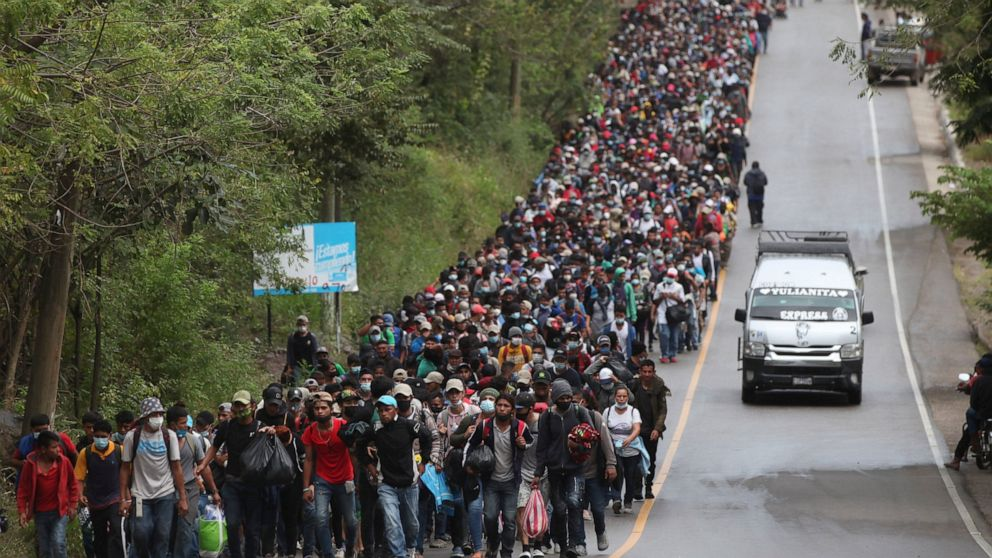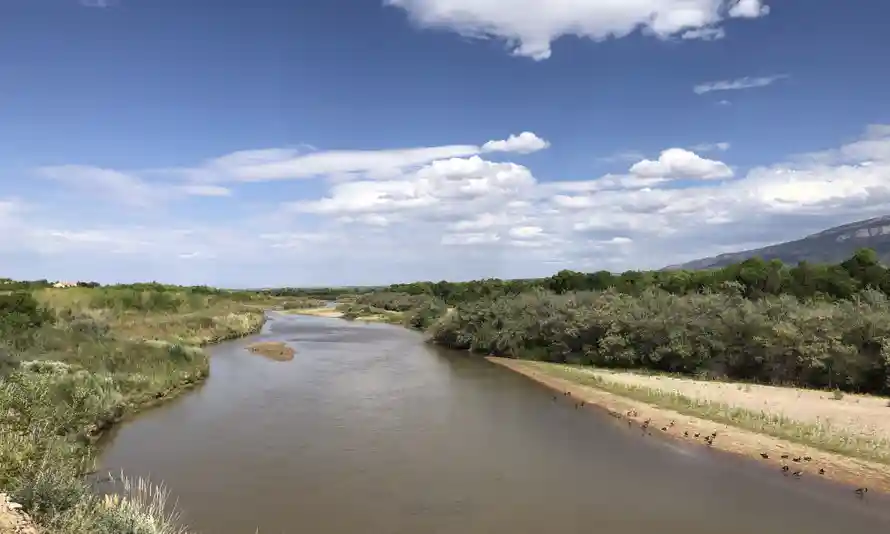
微信公众号:unopnews 希望是有羽毛的东西,它栖息在灵魂深处唱着没有语言的曲子,永远不会停止。
Rethinking immigration, how does Biden build border order?
Reform desire
In January 2017, Trump officially took office as the 45th President of the United States. And just after he became president, as he promised during his campaign, he began to pursue persecution and restrictions on immigration, especially undocumented immigrants, refugees and asylum seekers at the southern border. During his four years as president, the U.S. government has pushed for disciplinary restrictions on immigration on many fronts: pushing for a “Muslim travel ban,” massively increasing Immigration and Customs Enforcement (ICE) enforcement The number of deportations, the implementation of the "zero tolerance" undocumented immigrant family separation policy, the revocation of the Deferred Action for Childhood Arrivals (DACA), the suspension of the "Temporary Protected Status" (Temporary Protected Status, provided to those who are in the United States, Temporary status for eligible nationals of designated countries fleeing armed conflict)”, a series of policies such as the mass repatriation of Central American asylum applicants have not only been criticized domestically and internationally, but have also completely changed the way American society faces immigration issues. pattern.
Under the current circumstances, more and more people, the media and scholars have gone from being indifferent to the immigration issue to feeling the seriousness of the situation. If the influence of Trump and the Republican Party who chooses to cooperate fully with Trump on these issues is not clear soon, the immigration problem in the United States will further become an irreparable chaos. Unfortunately, as the new crown virus raged in the United States and around the world, such chaos broke out completely in the last year of Trump's administration: In detention centers held by ICE, more than half of the detainees were regularly infected with the virus. , while riots broke out in detention centers run by private prison companies.

Jeff Koterba
During Biden's run for president, he made changing and repealing Trump's immigration policies an important part of his executive agenda. And after he became president, he did make a drastic change in some Trump-era immigration restrictions by signing an executive order. As president, Biden halted the travel ban, reinstated DACA, reduced ICE deportations, reinstated "temporary protected status," asked DHS to reunite families separated by the Trump administration, and restored refugee claims to Obama-era numbers and stop forcing asylum seekers to apply in their home countries. This series of actions has also been praised by a large number of Democratic politicians and immigrant rights advocates.
Not only that, but Biden also pushed a bill called the "American Citizenship Act" to Congress, which would provide all undocumented immigrants living in the United States with a way to obtain permanent residency or citizenship. Although this bill is difficult to pass in its current form, it is enough for many to see Biden's boldness.
But are these actions enough? Can Biden make America's immigration system, especially for these vulnerable groups, more tolerant and humane just by undoing some of the oppressive policies practiced during Trump's administration? Has the urgency of the immigration issue changed? Are the vulnerable people who have been hit hard during the Trump administration really safe?
The harsh reality has dealt a major blow to Biden's rhetoric and ambitions on immigration. Just as Biden is juggling with Congress to push through legislation to further change many of the problems that existed long before Trump, on the U.S.-Mexico border, a wave of refugees already predicted by the media and experts turned out to be the case. It tore apart the weak consensus that Biden and Congress had just reached on immigration, and caught the Biden administration by surprise.

Adam Schultz / The White House
In March and April, Border Patrol caught more than 170,000 refugees trying to force their way across the border between the United States and Mexico. That number was up 63 percent from April 2019 and includes a large number of young men going it alone to try and find work in the United States. They can only be forcibly returned to a "waiting zone" in Mexico under existing DHS regulations. In addition, in March and April, nearly 20,000 unaccompanied minors crossed the border illegally under the guidance of cartels or others, and were temporarily placed in ICE or U.S. military custody in accordance with regulations. At the base managed by Fang, these children also faced shortages in hygiene and diet.
The crisis has also brought accusations from both sides of Biden: the right has accused him of refusing to acknowledge that immigration at the U.S.-Mexico border has become a serious national security crisis, while the left has criticized his Department of Homeland Security for its treatment of immigrants entering the country. Refugees and children are inhumane and are still continuing a series of Trump-era behaviors.
Crisis comes
People living in Central America, especially the three countries of the "Northern Triangle" (Honduras, El Salvador, Guatemala), have been plagued by civil war and gang conflict for decades. In these countries, governments are perennially corrupt, poverty rates remain high, and social order is often thrown into chaos. As a result, since the 1990s, nationals of these countries have been the mainstay of the long journey to the US-Mexico border to survive in the US by applying for asylum or refugee status.
In 2020, the situation was even worse for these people: Two Category 4 hurricanes in November brought showers and severe natural disasters that killed more than 200 people and affected more than 5.3 million. For many families, the hurricane completely took away the possibility of them staying and living in the local area, because everything that belonged to them had been swept away by floodwaters or buried under the mountain by mudslides.
The still-raging Covid-19 pandemic means that many hurricane-affected people will not be able to find jobs that subsidize their families, and they will not be able to properly rebuild what they have. In all three countries, UN investigators have been receiving reports of food shortages and even famines. At the same time, the governments of these countries are ineffective at rebuilding due to government incompetence, further prompting many of them to vote with their feet to choose a new life in the United States by applying for asylum or asylum.

John Moore / Getty
In Biden's view, the existing administration is not ready to accept these hundreds of thousands of refugees into the country. For him, the overriding issue is restoring order within the United States after Trump left. So, in addition to his own name, Biden, through his Vice President Harris and his Homeland Security Secretary Alejandro Mayorkas, frequently discouraged these refugees in press conferences, allowing They don't want to cross the US-Mexico border and enter the US "at this moment." To achieve this, he reached an agreement with the three countries, granting them a larger disaster relief payment than before, up to $310 million.
For many immigrant rights advocates, the funding isn’t just a measure of humanitarian aid; it’s also a deterrent to these countries to curb immigration flows, a state-level “hush money.” Bush, Obama and Trump have used this approach to try and control the number of Central American refugees entering the US-Mexico border during their presidencies. In fact, for the nationals of these Central American countries, these aids will not deter them from choosing to enter the United States.
According to a study on violent conflict and migration, international aid to these countries is often ineffective in changing the reality of these countries, in part because of the lack of targeted financial aid measures. In addition, as economic conditions improve, people with family members in the United States, or with a certain level of disposable income, will instead use relief assistance to immigrate to them in order to choose a better and more stable life. Where it is believed that a more equitable opportunity can be provided. Surveys of the origins of these refugees further corroborate this claim: the data show that the majority of Central American refugees entering the U.S. do not come from the most transported and impoverished regions of these countries.
And due to global warming, climate anomalies are increasing year by year. With the northern triangle in the hurricane belt, similar refugee flows are likely to intensify and increase in size. Biden himself and the U.S. Congress should be clear that it is impossible to prevent undocumented immigrants from entering the United States through the border. What needs to be done is to pass potential reform measures, really face this crisis directly and will pass a series of political measures to build a more humane immigration system.

Sandra Sebastian / AP
face the challenge
To solve a problem, you must first understand the nature of the problem. In order to gain partisan and social support for their policies in the United States, Biden and members of his administration have assured everyone in press conferences and interviews time and time again that the problems and crises at the border are gradually being resolved. That's what Biden and members of his administration are saying even as the number of people crossing the border tops 170,000 in a row, the highest number in two decades. Such attitudes have begun to receive increasingly negative feedback in areas close to the border; Democratic Rep. Henry Cuellar, whose constituency is on the U.S.-Mexico border, even publicly refuted and rejected Biden in interviews Regarding the border issue, it is believed that the crisis is far from being resolved.
Cuellar's concerns are not without reason: In several U.S.-Mexico border cities, smugglers and cartels are "transporting" these undocumented migrants across the border. Some of them are able-bodied, but many are old and young, even minors. Some of them will go through tunnels under the border wall, some will break the fence, and some will take great risks to cross the fast-moving Rio Grande. Many local residents are seriously concerned about the increase in illegal border crossings, as it has led to the recent massive increase in law enforcement and high-speed pursuits, as well as an uptick in policing incidents. To make their dissatisfaction with the current situation even more explicit, many had already made political choices ahead of this year's refugee wave, voting in the 2020 election for Trump, who once called Mexicans "rapists" .

Susan Montoya Bryan / AP
For some residents living next to the border who choose to change their political stance, it is hard not to doubt that Biden's election and the arrival of the refugee wave happened almost simultaneously. Not to mention Republican politicians who want to try to dissuade illegal border crossings through mass deportations and detentions, and even Democratic representatives in these districts share Cuellar's concerns. For them, such illegal border crossings, as an ongoing norm, must be addressed urgently, otherwise the existing political climate and social media exaggeration will further weaken the Democratic Party's already waning influence here, so much so that the existence of this One form gives Democrats the possibility of losing control of the Senate and House of Representatives.
And in cities like Tijuana, Mexico, which border the U.S. border, many asylum seekers still feel they are being abandoned. Since Biden was elected president, more and more refugee camps have started popping up in these cities, many of whom are expecting a decree from the president to allow them all to enter the United States. The camps are always at risk due to unsanitary conditions, drug use and gang access, and several asylum seekers awaiting immigration court have died from gang violence.
Although Biden lifted the policy that asylum seekers had to stay in Mexico and closed an asylum application center originally set up in Mexico to resettle these people, the still raging epidemic and the huge backlog during the Trump era mean that The continuation or even increase of refugee camps and illegal border crossings seems inevitable. In an effort to deport all illegal border crossers as quickly as possible, Trump reinstated a 1944 public health policy in 2020 that bypassed the normal arrest process and denied them the opportunity to claim humanitarian protection. So far, Biden has not lifted the order, and the vast majority of adults who cross the border will still be deported.
This ongoing migration crisis is a tragic cycle and a huge humanitarian catastrophe. The large numbers of Central Americans and Mexicans who want to change the status quo may well have been expecting to improve the status quo by crossing the border in search of work; this force has not been stopped by Trump's deterrence and brutality. For Biden, who has always pledged to shape a "human immigration system," he still has a lot of advice from scholars and social activists to adopt.
Focusing directly on violence as a driver of refugee emergence can reduce the volatility of border crossings and is an important step in building a humane immigration system, according to Nicole Narea, a reporter for the news site Vox. In the Northern Triangle, an increase in homicides is the top reason behind the mass influx of unaccompanied children across the border. Because the governments of these three countries are very corrupt, aid at the national level is likely to be unable to directly address immediate social problems in these regions. A 2014 USAID study found that community-level interventions can reduce street-level homicides by 50 percent. The U.S. government's special envoy for the Northern Triangle has also publicly stated that, in addition to government leaders, talking to social issue groups and members of the private sector in the region, as well as the media, is also a focus of his work.

Herika Martinez/AFP
Next, as the epidemic continues to improve in the United States with the promotion of vaccines, Biden is likely to choose to lift the existing repatriation policy based on public health policies, thereby easing the current situation of a large number of refugees stranded in Mexico. Today, the Biden administration is only able to process information on 250 asylum seekers a day, which is far from enough for the current number of refugees. This situation means that reorganizing the immigration court system to allow more judges to process and manage asylum applications is essential and far safer than forced deportation if border congestion is to be resolved. and more humane treatment. From the perspective of UNHCR, the U.S. government is now well equipped to provide refugees with basic rights while protecting public health.
And for the growing number of underage children at the border, the United States has ensured the safety of these children as early as 2008 through the Trafficking Victims Protection Reauthorization Act: if these children are not from Mexico, then They must be transferred to the Office of Refugee Resettlement, which is part of the U.S. Department of Health and Human Services, within 72 hours. After that, they will transfer the children to a shelter or relatives living in the United States, and then be assigned a specific date in immigration court to legally secure their stay in the United States. In this crisis, after a large number of minors entered the border, the refugee resettlement office temporarily failed to guarantee drinking water, and the detention time was far more than three days. It also indicates that the Biden administration needs to increase investment in these aspects. mobilization of resources beyond Border Patrol and Refugee Resettlement Offices, and the use of Federal Emergency Management Agency (FEMA)-run agencies as resettlement sites may also become the norm in the future.
In addition, the most important part is to use diplomatic means to cooperate with Mexico and other Central American countries to stop the huge influence of smugglers and cartels in this process; this is in addition to increasing Aside from dealing with refugee funding, the one thing many agencies calling for immigration reform want most from Biden. For many refugees, their only route, Mexico, is Biden's most important target. Mexico's ability to limit immigration gives its government significant leverage on an issue that is a political weakness for Biden. In exchange for a flood of vaccines, Mexico closed its borders with Guatemala and Belize in March and deployed the military and police to control the movement of refugees within the country. Although there is not much consensus between Biden and Mexican President Lopez, only such mutual assistance can solve this problem.
For the complex immigration form, the U.S. government unilaterally does not have the ability to stop immigrants from the northern triangle, but the United States can indeed regain control of the credibility of immigration discussions in the U.S. public and undocumented immigrants by implementing more people-oriented policies. The initiative in the process, so that this process can be streamlined and normalized, and is no longer regarded as a "crisis".
References:
Aleaziz, Hamed. “ICE Changed Its Targets, But Critics On Both Sides Remain.” BuzzFeed News , 20 May 2021, www.buzzfeednews.com/article/hamedaleaziz/ice-arrests-priorities-biden-critics.
Berk-Seligson, Susan, et al. “Impact Evaluation of USAID's Community-Based Crime and Violence.” USAID , Oct. 2014, www.usaid.gov/documents/1862/impact-evaluation-usaids-community-based-crime- and-violence-prevention-approach.
Call, Charles. “The Imperative to Address the Root Causes of Migration from Central America.” Brookings , 29 Jan. 2021, www.brookings.edu/blog/order-from-chaos/2021/01/29/the-imperative- to-address-the-root-causes-of-migration-from-central-america.
Clemens, Michael A. “Violence, Development, and Migration Waves: Evidence from Central American Child Migrant Apprehensions.” Center for Global Development , 2017, pp. 1–52. Crossref , doi:10.2139/ssrn.3013379.
Dwyer, Mimi, and Lizbeth Diaz. “How Confusion around Biden Policies Birthed a New Refugee Camp on the US Border.” Reuters , 10 May 2021, www.reuters.com/world/us/how-confusion-around-biden-policies -birthed-new-refugee-camp-us-border-2021-05-07.
Fox, Ben. “Trump Leaves Mark on Immigration Policy, Some of It Lasting.” Associated Press , 30 Dec. 2020, apnews.com/article/joe-biden-donald-trump-politics-immigration-united-states-a5bfcbea280a468b431a02e82c15a150.
Hackman, Michelle, and Alicia Caldwell. “Surge of Migrants at US Southern Border: Biden's Immigration Plan and What You Need to Know.” WSJ , 12 May 2021, www.wsj.com/articles/surge-of-migrants-at- us-southern-border-bidens-plan-and-what-you-need-to-know-11616788003.
Hernández, Arelis R. “In South Texas, Frustration With High-Speed Chases, Increased Crime Exacerbates Political Tensions.” Washington Post , 4 May 2021, www.washingtonpost.com/immigration/texas-border-crime/2021/05/03 /749b4b5a-994b-11eb-b28d-bfa7bb5cb2a5_story.html.
Isacson, Adam, et al. “Putting the US-Mexico 'Border Crisis' Narrative into Context.” WOLA , 18 Mar. 2021, www.wola.org/analysis/putting-border-crisis-narrative-into-context-2021 /?utm_source=WOLA Mailing List&utm_campaign=c04fd3c8af-EMAIL_CAMPAIGN_2021_03_17_02_34&utm_medium=email&utm_term=0_54f161a431-c04fd3c8af-141364933.
Miroff, Nick, and Mary Beth Sheridan. “As US Seeks to Outsource Immigration Enforcement, Mexico Gains Leverage.” Washington Post , 3 May 2021, www.washingtonpost.com/national/mexico-immigration-enforcement-leverage/2021/05/ 02/ca2af3aa-a854-11eb-b166-174b63ea6007_story.html.
Montoya-Galvez, Camilo. “Biden's First 100 Days: How US Immigration Policy Has — and Hasn't — Changed.” CBS News , 28 Apr. 2021, www.cbsnews.com/news/biden-first-100-days- immigration-policy.
Narea, Nicole. “Biden Plan to Send Foreign Aid to Central America Won't Deter Migrants.” Vox , 30 Apr. 2021, www.vox.com/policy-and-politics/22404000/foreign-aid-biden-central- America-migration-root-causes.
Narea, Nicole. “Migrants Are Heading North to the US Because Guatemala and Honduras Haven't Recovered from Storm Damage.” Vox , 22 Mar. 2021, www.vox.com/policy-and-politics/2021/3/22/ 22335816/border-crisis-migrant-hurricane-eta-iota.
Nowrasteh, Alex. “President Trump's Lasting Immigration Legacy.” Cato Institute , 9 Nov. 2020, www.cato.org/blog/president-trumps-lasting-immigration-legacy.
Selee, Andrew, et al. “Laying the Foundation for Regional Cooperation: Migration Policy & Institutional Capacity in Mexico and Central America.” Migrationpolicy.Org , 26 Apr. 2021, www.migrationpolicy.org/research/regional-cooperation-migration- capacity-mexico-central-america.
Shear, Michael D. “Congressional Democrats Roll out Biden's Immigration Plan, Offering an Eight-Year Path to Citizenship.” The New York Times , 19 Feb. 2021, www.nytimes.com/2021/02/18/us/congressional- democrats-roll-out-bidens-immigration-plan-offering-an-eight-year-path-to-citizenship.html.
Sieff, Kevin. “Massive Family Reunification Effort Starts with a Mother and Son at the Border.” Washington Post , 4 May 2021, www.washingtonpost.com/world/2021/05/04/migrant-family-separation-reunification-border .
Sullivan, Sean. “Biden Says He Will Raise Refugee Cap from 15,000 to 62,500, after Widespread Criticism for Extending Trump-Era Levels.” Washington Post , 4 May 2021, www.washingtonpost.com/politics/biden-refugee/2021/05 /03/1b833126-ac4d-11eb-ab4c-986555a1c511_story.html.
“UNHCR Chief Calls on US to End COVID-19 Asylum Restrictions at The.” UN News , 22 May 2021, news.un.org/en/story/2021/05/1092352.
Walsh, Joe. “Southern Border Crossings Hit Record Levels Last Month — But Surge Slowing Down.” Forbes , 12 May 2021, www.forbes.com/sites/joewalsh/2021/05/11/southern-border-crossings-hit- record-levels-last-month---but-surge-slowing-down/?sh=72d98f3077b9.
Like my work?
Don't forget to support or like, so I know you are with me..
Comment…